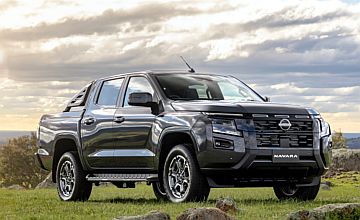Make / Model Search
OptionsCar reviews - Nissan - NavaraNissan modelsOverviewWe like Nissan-ised frontal styling works well; new damper tune shows promise; off-road prowess virtually assured Room for improvement No mechanical or interior differences over donor; rationalised range will exclude some buyers; pricing still unknown We take a brief drive of the Mitsubishi Triton-based Nissan Navara ahead of its 2026 launch26 Nov 2025 By MATT BROGAN Overview
NISSAN has finally taken the convers of its Mitsubishi Triton-based Navara, the model arriving with a new look front and rear, and a set of Monroe-sourced dampers tuned by Aussie engineering firm Premcar to take some of the harshness from the donor’s ride.
Essentially, that’s really all there is to it…
Without wanting to sound sensationalist, the new Navara really is that closely aligned with its Triton donor – sharing the same chassis underpinnings, the majority of its body panels, all of its driveline, steering and brakes, cabin fit-out, safety technology, and equipment levels.
Of course, Nissan isn’t Robinson Crusoe in partnering to release a dual-cab ute.
Isuzu and Mazda share the D-Max and BT-50, Ford and Volkswagen share the Ranger and Amarok, MG and LDV share the U9 and Terron 9, and so on and so on. Yes, folks, badge engineering is alive and well in 2025; much the same as it has been for decades.
But unlike many of the models listed above, it’s Nissan that has taken something of an abridged approach to releasing its latest Navara.
Gone is the two-wheel drive, single- and King cab body styles, the cab-chassis option, and all but the highest model grades. Nissan has also ditched the manual transmission this time around leaving only the dual-cab, automatic, turbo-diesel pick-up in ST-X and PRO4-X trim.
The importer is also expected to release a flagship Warrior variant in due course, showcasing a prototype example at a recent event in South Australia.
The Navara runs the same 4N16-series twin-turbocharged four-cylinder diesel as the Mitsubishi Triton. Displacing 2.4 litres, the unit delivers a familiar 150kW at 3500rpm and 470Nm at 1500rpm to return a claimed combined cycle fuel consumption figure of 7.7 litres per 100km.
Paired exclusively with an Aisin-sourced six-speed automatic transmission, the configuration is married to an ‘Easy 4WD’ system that automatically switches between two- and four-wheel drive as required and is paired as standard with an electronically activated locking rear differential.
Higher grade ST-X and PRO-4X grades (again, the only grades detailed for now) receive a new ‘Super 4WD’ system that offers full-time high-range four-wheel drive with an open centre differential and Torsen limited slip rear differential Nissan says is tuned to deliver “optimised torque distribution” irrespective of terrain.
Seven pre-programmed selectable terrain modes are offered including Normal, Eco, Gravel, Sand, Mud, Sand, and Rock.
Finally, we noted a newly adopted Electric Power Steering (EPS) system in place of the former hydraulic unit that Nissan says benefits both the driving experience and fuel economy.
Drawing inspiration from the nameplate’s heritage, the Navara integrates signature elements that connect it with its past, while at the same time embracing more contemporary brand styling cues, such as the V-strut grille.
Members of Nissan’s global design team travelled to Australia to study ute culture and were inspired by the modified utility and four-wheel drive scene which led to a “bull bar inspired” take on the V-strut shield, establishing what Nissan says is a “commanding” frontal presence.
The three-slot design atop the grille pays tribute to the D21-series Navara, while the signature C-shaped headlights are said to “interlock seamlessly with the grille”, a recurring theme in modern Nissan utility models and SUVs.
For now, equipment highlights include a standard 9.0-inch central touchscreen infotainment array features DAB+ digital radio reception, Android Auto and wireless Apple CarPlay connectivity as standard fare, while ST-X and PRO-4X grades add wireless smartphone charging within the lower instrument panel.
Further, MyNissan connected car services include remote features such as HVAC control, emergency call functionality, stolen vehicle tracking, and more – something not found on the Mitsubishi Triton.
The instrument panel combines a 7.0-inches digital screen between a pair of analogue gauges, just like the Triton donor.
On the all-important safety front, we find the 2026 Nissan Navara range offering as standard eight airbags, emergency lane assist, all-LED lighting with auto high beam, traffic sign recognition, blind spot detection, autonomous emergency braking, front- and rear cross-traffic alert, driver monitoring functionality, available (read: grade dependent) adaptive cruise control, and more.
As is the case elsewhere in Nissan Australia’s portfolio, the new Navara will be backed by a 10-year/300,000km warranty when the vehicle is service through the Nissan dealer network. Flat price servicing is available for five years, while roadside assistance coverage matches the duration of the vehicle warranty.
The full list of available accessories, as well as the model grade strategy and localised pricing, will be announced closer to the Navara’s local arrival in the first quarter of 2026.
Driving Impressions
Being a preview drive offered well ahead of the Navara’s official media launch, our time with the vehicle in South Australia was indeed very limited. Entirely off-road, and away from prying eyes, the opportunity was offered as something of a taste test ahead of the March main course.
Driving the new Navara through a four-wheel drive park at very low speeds – and not on the black-top where fuller exploration of the changes to the vehicle’s suspension might be more tangible – gave us little clue as to how the vehicle rides and handles.
While we’re pleased to note that it handled everything thrown at it with aplomb, the preview drive centred solely on high- and low-range four-wheel driving over challenging terrain. Larger bumps and ruts showed a fraction more suspension compliance over the Triton, the remainder of the package feeling rather similar.
And that’s no bad thing… The Triton offered several massive steps forward over its predecessor, steps that are equally large in comparing the old and new Navara.
The cabin is quieter and more contemporary in its layout. It feels roomier and offers a decent view out, just the thing for gnarly off-road tracks.
We found a willingness in low-end engine response the outgoing Navara can’t hope to match, the Mitsubishi engine and Aisin transmission pairing providing willing torque at middling engine speeds, suggesting Nissan’s offering will offer the same kind of around-town flexibility we’ve come to know from the Triton.
The electrically assisted steering is another win for Navara owners, feeling far better ‘dialled in’ than the aging model. It’s well assisted for off-road work, but no so light as to be devoid of feel. It’s another part of the package we can’t wait to sample at higher speeds where the more rigid chassis and Aussie-tuned dampers are certain to offer a uniquely Navara character.
As is the case in the Triton, the Super Select II four-wheel drive system is easy to use. It makes light work of off-road driving and is simple enough to operate when you’re busy picking lines. The traction smarts of the Mitsubishi system will offer Navara buyers a far greater choice in selecting the right driving mode for varied terrains, showing no signs of wheel slip at all on the mixed course sampled.
Of course, we’ll need to wait until the Australian launch review to offer our opinion on the Navara’s ride and road-holding abilities, its load hauling and towing prowess, the calibration of its ADAS systems, and how it stacks up on price.
For now, these factors and more (like if and when a cab-chassis and other variants will be made available) remain a closely guarded secret with Nissan advising us to wait until the New Year. Like many other prospective Navara buyers, that wait is one we will endure with anticipation, our first taste of the all-new model suggesting there’s going to be a lot to like.
 Read more24th of November 2025  Nissan rationalises Navara line-upJust three dual-cab 4WD variants to be offered, potentially limiting Navara’s sales success19th of November 2025  Navara PRO-4X Warrior Concept takes shapePremcar’s Navara PRO-4X Warrior Concept hints at direction of next generation off-road ute19th of November 2025  Navara specifications up the ante on predecessorLatest gen’ Navara draws on Alliance partner Mitsubishi Triton, delivers comparable specs19th of November 2025  Nissan Navara makes global debut in AusDouble-cab next-generation Navara debuts on Alliance platform, in showrooms next year12th of November 2025  Navara: tuned for all suspension scenariosNissan says collaboration with Premcar ensures new Navara ute will handle work and playAll car reviews Alfa Romeo Alfa Romeo Abarth Abarth Audi Audi Aston Martin Aston Martin BMW BMW Bentley Bentley Chrysler Chrysler Chevrolet Chevrolet Dodge Dodge Citroen Citroen Ferrari Ferrari DS DS Ford Ford Fiat Fiat FPV FPV Foton Foton Haval Haval Great Wall Great Wall Honda Honda Holden Holden Hyundai Hyundai HSV HSV Isuzu Isuzu Infiniti Infiniti Jaguar Jaguar Iveco Iveco Kia Kia Jeep Jeep Land Rover Land Rover Lamborghini Lamborghini Maserati Maserati Lexus Lexus McLaren McLaren Mazda Mazda Mercedes-Benz Mercedes-Benz Mitsubishi Mitsubishi Mini Mini Opel Opel Nissan Nissan Porsche Porsche Peugeot Peugeot Ram Ram Proton Proton Rolls-Royce Rolls-Royce Renault Renault Skoda Skoda Saab Saab SsangYong SsangYong Smart Smart Suzuki Suzuki Subaru Subaru Toyota Toyota Tesla Tesla Volvo Volvo |
OptionsClick to share
|











Facebook Twitter Instagram